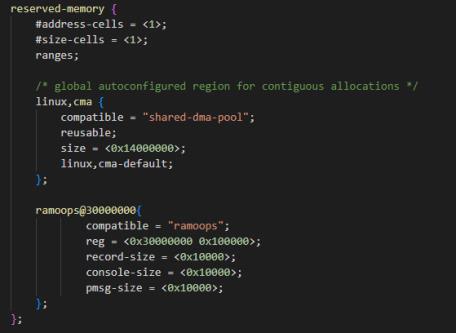嵌入式Linux上使用Ramoops
Posted toradexsh
tags:
篇首语:本文由小常识网(cha138.com)小编为大家整理,主要介绍了嵌入式Linux上使用Ramoops相关的知识,希望对你有一定的参考价值。
By Toradex胡珊逢
对于嵌入式设备,尽管在部署前会经历大量的测试和验证,但在使用现场有时候仍不可避免会出现意外情况,如 Kernel opps、panic。当出现类似情况时,系统日志往往无法及时写入 flash,重启后不能获得用于分析问题的关键信息。Ramoops 可以应对此类问题。当发发生 Kernel opps、panic时,它能够将相关日志保存到特定的内存区域,并在软重启后仍可以读取。文章将使用安装 Linux BSP v3.0 的 Apalis iMX6 计算机模块进行说明。
首先使用 Toradex Easy Installer 安装 Linux BSP v3.0。然后下载对应的 Linux 源码,分支为 toradex_4.14-2.3.x-imx。交叉编译工具是 gcc-arm-8.2-2019.01-x86_64-arm-linux-gnueabihf。
应用 Apalis iMX6 默认内核配置。
-----------------------------------------
$ make apalis_imx6_defconfig
-----------------------------------------
开启 ramoops 功能。
-----------------------------------------
$ make menuconfig
File systems → Miscellaneous filesystems
<*> Persistent store support
Choose compression algorithm (ZLIB) --->
[*] Log kernel console messages
[*] Log user space messages
<*> Log panic/oops to a RAM buffer
-----------------------------------------

为了便于触发 kernel panic 开启 sysrq 功能。
-----------------------------------------
Kernel hacking
[*] Magic SysRq key
0x1) Enable magic SysRq key functions by default
[*] Enable magic SysRq key over serial
-----------------------------------------

最后重新编译内核以及内核模块。
-----------------------------------------
$ make zImage LOADADDR=10008000
$ make modules
-----------------------------------------
使用新的内核和模块重新启动 Apalis iMX6。Ramoops 在内核配置里又称为 PSTORE,使用下面命令查看之前的内核内置是否生效。
-----------------------------------------
root@apalis-imx6:~# zcat /proc/config.gz |grep PSTORE
CONFIG_PSTORE=y
CONFIG_PSTORE_ZLIB_COMPRESS=y
# CONFIG_PSTORE_LZO_COMPRESS is not set
# CONFIG_PSTORE_LZ4_COMPRESS is not set
CONFIG_PSTORE_CONSOLE=y
CONFIG_PSTORE_PMSG=y
CONFIG_PSTORE_RAM=y
root@apalis-imx6:~# zcat /proc/config.gz |grep SYSRQ
CONFIG_MAGIC_SYSRQ=y
CONFIG_MAGIC_SYSRQ_DEFAULT_ENABLE=0x1
CONFIG_MAGIC_SYSRQ_SERIAL=y
-----------------------------------------
此时,ramoops 还没有配置完成,需要在 device tree里创建对应的节点。在这之前先确定在内存中可以为 ramoops 预留的地址空间。在 Linux 运行下面命令。
-----------------------------------------
root@apalis-imx6:~# cat /proc/iomem
00100000-00103fff : /soc/caam-sm@00100000
00120000-00128fff : 120000.hdmi_core
00130000-00133fff : galcore register region
……
02204000-02207fff : galcore register region
02400000-027fffff : 2400000.ipu
02800000-02bfffff : 2800000.ipu
10000000-4fffffff : System RAM
10008000-10cfffff : Kernel code
10e00000-10eeb3cf : Kernel data
-----------------------------------------
RAM 的物理地址空间为 0x10000000-0x4fffffff,选择在 Kernel code 和 Kernel data 之外的 0x30000000 作为 ramoops 的起始地址,大小为 1MB。
在 arch/arm/boot/dts/imx6q.dtsi 的 reserved-memory 节点里添加 ramoops。

重新编译 device tree。
-----------------------------------------
$ make imx6q-apalis-eval.dtb
-----------------------------------------
使用新的 device tree 启动后,可以看到以下信息。
-----------------------------------------
root@apalis-imx6:~# dmesg|grep ramoops
[ 0.071682] pstore: Registered ramoops as persistent store backend
[ 0.071707] ramoops: attached 0x100000@0x30000000, ecc: 0/0
-----------------------------------------
下面命令分别设置系统在发生 kernel panic 时1 秒后自动重启,以及触发 kernel panic。
-----------------------------------------
root@apalis-imx6:~# echo 1 > /proc/sys/kernel/panic
root@apalis-imx6:~# echo c > /proc/sysrq-trigger
-----------------------------------------
在自动重启后,将 ramoops 挂载到 /home/root/pstore 目录,可以看到上次发生 kerne panic 时的日志。
-----------------------------------------
root@apalis-imx6:~# mkdir -p /home/root/pstore
root@apalis-imx6:~# mount -t pstore psotre /home/root/pstore
root@apalis-imx6:~# ls pstore/
console-ramoops-0 dmesg-ramoops-0 dmesg-ramoops-1
root@apalis-imx6:~/pstore# tail -n 5 console-ramoops-0
[ 856.337055] ffa0: 00be5898 00000000 00000020 76ed4bb4
[ 856.345259] ffc0: 00be5898 00000020 00000002 00000001 76ed71c0 00be6828 00000001 7ed702e0
[ 856.353460] ffe0: 00000000 7ed70138 76dd382d 76d88cd0 000f0010 ffffffff
[ 856.360101] r9:00be6828 r8:10c5387d r7:10c5387d r6:ffffffff r5:000f0010 r4:76d88cd0
[ 856.385215] Rebooting in 1 seconds..
root@apalis-imx6:~/pstore# tail -n 5 dmesg-ramoops-0
<4>[ 856.200454] r9:00000000 r8:00000000 r7:00000002 r6:00d00440 r5:a909bf00 r4:a909bf00
<4>[ 856.208233] [<80227be8>] (SyS_write) from [<80107d20>] (ret_fast_syscall+0x0/0x54)
<4>[ 856.215828] r9:a975a000 r8:80107f24 r7:00000004 r6:76f5bda0 r5:00d00440 r4:0000006c
<0>[ 856.223594] Code: e5834000 f57ff04e ebf07aaa e3a03000 (e5c34000)
<4>[ 856.229847] ---[ end trace 583cc693cbfd2cb1 ]---
-----------------------------------------
由于 ramoops 是将日志保存在内存里,如果模块是冷启动,即电源复位,那么相关的内容也不再保留。
-----------------------------------------
root@apalis-imx6:~# mount -t pstore psotre /home/root/pstore
root@apalis-imx6:~# ls pstore/
root@apalis-imx6:~#
-----------------------------------------
参考
https://git.toradex.cn/cgit/linux-toradex.git/tree/Documentation/admin-guide/ramoops.rst?h=toradex_4.14-2.3.x-imx
https://lwn.net/Articles/501748/
总结
ramoops 可以使用较小的开销记录系统日志一般难以保存的 kernel panic 错误。由于存储于内存里面,因此在掉电后这些信息就不复存在。在 Linux 中还有许多其他的调试方法,如kdb, kdump, tracing 等,它们的使用特点和复杂程度也各有不同,用户可以根据需求加以选择。
以上是关于嵌入式Linux上使用Ramoops的主要内容,如果未能解决你的问题,请参考以下文章